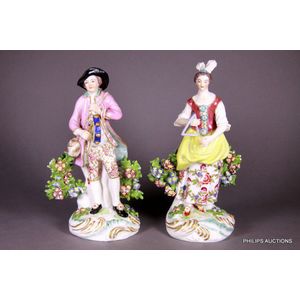Derby & Bow Soft Paste Figures, 1765
You must be a subscriber, and be logged in to view price and dealer details.
Subscribe Now to view actual auction price for this item
When you subscribe, you have the option of setting the currency in which to display prices to $Au, $US, $NZ or Stg.
- Rustic - Rustic is defined as "of, relating to, or typical of country life or country people", and the items illustrated in this price guide accord with that definition.
But in the 18th and 19th century "rustic furniture" had a narrower definition. It referred to furniture where the framework was carved or moulded to resemble tree trunks and branches, and was usually for outdoor use. Rustic furniture was made in cast iron, wood, terracootta and concrete. Much of the Coalbrookdale company's cast iron furniture was of rustic design. - Soft Paste Porcelain - Porcelain is an ancient ceramic material, first made in China, hence the common name "china", and the process was unknown in the West.
European potters attempted to replicate Chinese porcelain, without knowing the ingredients in its composition, and the earliest wares were produced with mixtures of clay and ground-up glass (frit), the idea being that the glass would give the porcelain translucency.
It was given the name "soft" because it did not remain rigid, but "slumped" when fired in the kiln at high temperatures. - Circa - A Latin term meaning 'about', often used in the antique trade to give an approximate date for the piece, usually considered to be five years on either side of the circa year. Thus, circa 1900 means the piece was made about 1900, probably between 1895 and 1905. The expression is sometimes abbreviated to c.1900.
This item has been included into following indexes:
Visually similar items

Three miniature figures, probably Derby, Chelsea, other, 18th to 19th century, a female figure in a white and yellow cape with highly coiffed hair, raised on a shallow white square base, in the manner of Derby; a figure of a Turk, bearing a Chelsea gold an

A pair of Chelsea musician figures, circa 1756-69, gold anchor period, an elegant pair, she with a plumed head piece, a floral skirt and lemon apron and playing a triangle, and he with brimmed hat, in a pink coat and floral breeches playing a tambourine, b

Two various Royal Doulton figures, including 'Sarah,' HN3380 (Certificate available), and 'Wintertime,' HN3060, height 23 cm (taller).

A Derby soft paste porcelain 'Boy Holding a Basket' on a Coalport pedestal, circa 1755, probably model 2 and circa 1830, with blue C D initials of period, a barefoot lad in fine pale colours with a tree trunk support, wearing lemon breeches, a teal coat an
